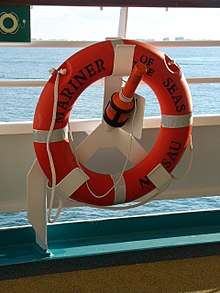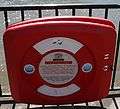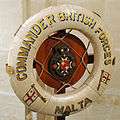Lifebuoy
A lifebelt, lifebuoy, water wheely, ring buoy, lifering, lifesaver, life donut or life preserver, also known as a "kisby ring" or "perry buoy", is a life saving buoy designed to be thrown to a person in the water, to provide buoyancy and prevent drowning. Some modern lifebuoys are fitted with one or more seawater-activated lights, to aid rescue at night.


Description
The lifebuoy is usually ring- or horseshoe-shaped and has a connecting line allowing the casualty to be pulled to the rescuer in a boat. They are carried by ships and are also located beside bodies of water that have the depth or potential to drown someone. They are often subjected to vandalism which, since the unavailability of lifebuoys could lead to death, may be punished by fines (up to £5,000 in the United Kingdom) or imprisonment.
The "kisby ring", or sometimes "Kisbie ring", is thought to be named after Thomas Kisbee (1792–1877) who was a British naval officer.[1]
The UK Royal Life Saving Society considers lifebuoys unsuitable for use in swimming pools because throwing one into a busy pool could injure the casualty or other pool users. In these locations, lifebuoys have been superseded by devices such as the torpedo buoy.[2]
In the United States, Coast Guard approved lifebuoys are considered Type IV personal flotation devices. At least one Type IV PFD is required on all vessels 26 feet or more in length.[3]
Leonardo da Vinci sketched a concept for a lifebuoy, as well as for buoyant shoes and balancing sticks for walking on water.[4]
.jpg) Leonardo da Vinci's design sketches for a lifebelt
Leonardo da Vinci's design sketches for a lifebelt First studies on the lifebuoy illustrated in the Acta Eruditorum, 1691
First studies on the lifebuoy illustrated in the Acta Eruditorum, 1691
Gallery of types of lifebuoys
- "Life ring" in Newport Beach, California
 A containered lifebuoy by the River Thames
A containered lifebuoy by the River Thames- Commercial use ring buoy aboard USCGC Eagle
- Aqualiner, containing ring buoy and rope
 Older style of lifebelt
Older style of lifebelt Lifebuoy in Ireland
Lifebuoy in Ireland Lifebuoy on a beach
Lifebuoy on a beach
See also
- Personal flotation device – Equipment to help the wearer keep afloat in water
- Pool float, also known as swimming float
- Swim ring
References
- "Kisby's of Note". Retrieved 2015-08-27.
- The Lifeguard. IQL UK Ltd. ISBN 1905008120.
- "46 CFR 25.25-5 Life Preservers and Other Lifesaving Equipment".
- Wallace, Robert (1972) [1966]. The World of Leonardo: 1452–1519. New York: Time-Life Books. pp. 106–07.
| Wikimedia Commons has media related to Lifebuoys. |
| Look up life jacket in Wiktionary, the free dictionary. |
